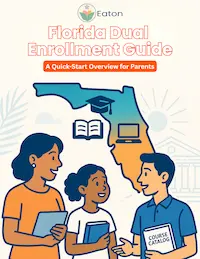PEP Hybrid vs. Part-Time: A Florida Parent’s Guide
Finding the right educational fit for your child can be challenging, especially when you have multiple flexible scholarship options. In Florida, the Personalized Education Program (PEP) offers two notable routes for students who aren’t enrolled full-time in a traditional school—PEP Hybrid and part-time enrollment. This guide will walk homeschooling parents through PEP Hybrid vs. Part-Time options, clarifying the differences, eligibility requirements, and how you can make the best choice for your child’s unique needs.
What Is the Personalized Education Program (PEP)?
The PEP scholarship allows parents to create a customized “bank account” for their child’s education, covering costs like tuition, fees, textbooks, curriculum, tutoring, and more. It’s particularly attractive for homeschooling families who value flexibility while still wanting partial support from an eligible private school or service provider.
- PEP Hybrid: Students attend an approved PEP Hybrid eligible private school at least two days per week, while completing the rest of their instruction at home (or another learning environment).
- PEP Part-Time: Students attend a private school for less than a full-time schedule, taking certain classes or extracurriculars but spending the majority of their educational time at home.
You’ll find more details on PEP guidelines, including yearly assessment requirements, on PEP in Florida: End-of-Year Testing Guidelines.
PEP Hybrid vs. Part-Time: Understanding the Basics
Both PEP Hybrid and part-time enrollment fall under the PEP umbrella, but there are some nuances worth exploring before you commit.
PEP Hybrid
- In-Person Requirement: Must be on campus at least two full school days per week.
- Hybrid Structure: The remaining instructional days are handled at home or through another educational approach you design.
- Approved Hybrid Schools: Only private schools approved by the Florida Department of Education (FLDOE) to offer PEP Hybrid qualify.
- Funding: Scholarship funds can pay the hybrid school directly for those in-person days and any additional fees.
Part-Time PEP
- On-Campus Classes: Students can take select classes, labs, or extracurricular activities at an eligible private school.
- Flexibility: Parents can blend schooling with online courses, co-ops, or other resources that meet PEP guidelines.
- Eligibility: Any private school that accepts FTC scholarships (and is registered with the FLDOE) can enroll PEP part-time students if it opts in, although it’s not labeled a “PEP Hybrid” school.
- Funding: Each class or activity typically gets billed through the Education Market Assistant (EMA) system or by reimbursement.
For a deeper dive into Florida’s broader homeschool rules—like annual assessments and attendance—visit Homeschool Requirements in Florida: A Practical How-to Guide.
Key Differences in PEP Hybrid vs. Part-Time
When deciding on PEP Hybrid vs. Part-Time, it helps to see the contrasts laid out:
- Minimum Attendance
- PEP Hybrid: You must attend the private school at least two full days weekly.
- Part-Time: There is no set minimum; you can sign up for a single class or multiple, depending on the school’s offerings.
- School Approval
- PEP Hybrid: The school must be approved specifically as a PEP Hybrid eligible private school. Not all private schools offering Florida scholarships meet these criteria.
- Part-Time: The school needs to be registered with the FLDOE and able to accept part-time students under the PEP scholarship, but not necessarily designated as “hybrid.”
- Instructional Approach
- PEP Hybrid: Generally, a semi-structured environment designed for two days of in-person classes, with assigned work to be completed at home the rest of the week.
- Part-Time: More of an à la carte approach. Students pick individual classes (like science labs or foreign languages) or extracurriculars, while the rest of their education remains parent-directed.
- Cost Differences
- PEP Hybrid: Families pay for the hybrid program’s tuition and fees. If costs exceed the total scholarship amount, parents must cover the difference.
- Part-Time: Expenses depend on the number and type of classes you sign up for. You pay only for chosen offerings—often less expensive than a hybrid program but can still add up if multiple courses or activities are selected.

PEP Hybrid vs. Part-Time: Eligibility and Scholarship Use
Both options require a valid PEP scholarship, which you can secure through Step Up For Students if your child is eligible. According to the Florida Department of Education, some key guidelines include:
- Grade Levels: K–12 students who can enroll in a Florida public school.
- Residency: Must be Florida residents (or dependent children of active-duty military with orders to Florida).
- Assessments: PEP students must submit an annual standardized assessment. Results must be uploaded through EMA, as explained in How to Use Florida Scholarship Funds Legally.
For more in-depth info on scholarship eligibility and application steps, check out How to Get a Step Up Scholarship for Florida Homeschoolers.
Advantages of PEP Hybrid vs. Part-Time
Before jumping into either format, here’s why families might choose one route over the other:
Benefits of PEP Hybrid
- Scheduled Structure: Having two set days on campus can benefit parents who need more routine in their weekly calendar.
- Community Interaction: Hybrid programs can offer the best of both worlds—face-to-face socialization and a sense of belonging, plus the flexibility of homeschool.
- Shared Responsibility: Certified teachers or faculty typically handle core instruction during in-person days, reducing parents’ teaching workload.
Benefits of Part-Time PEP
- Full Flexibility: With part-time enrollment, you can choose just the classes or extracurriculars your child needs (e.g., a specialized STEM class).
- Cost Control: You pay only for the classes or activities you sign up for, possibly making it more budget-friendly if you don’t need a full curriculum.
- Customized Curriculum: More freedom to select unique online programs or local homeschooling co-ops for the rest of the week.
If you’re exploring ways to blend these flexible schooling models with your homeschool day-to-day, you might find inspiration in Homeschool Florida: Your Ultimate How-to Guide or read about scheduling tips in Best Homeschool Schedule: How Many Hours Does It Take?.
Enrolling in PEP Hybrid vs. Part-Time
Regardless of which option you choose, you’ll navigate these key steps:
- Confirm Eligibility
- Make sure you have a valid PEP scholarship through Step Up For Students.
- Check with your chosen private school that it meets the criteria for either PEP Hybrid or part-time PEP enrollment.
- Create Your EMA Account
- The Education Market Assistant (EMA) is where you confirm your student’s enrollment and pay for services. For tips, see How to Set Up an EMA Account for Florida Scholarships.
- Agree on Tuition/Fees
- For PEP Hybrid, your agreement should reflect the cost for two in-person days (or more).
- For Part-Time, you’ll list each class or activity to be invoiced quarterly or as scheduled.
- Submit Required Assessments
- Students using PEP Hybrid or part-time must still complete a standardized test each year.
- Submit scores directly through EMA. Consult PEP in Florida: End-of-Year Testing Guidelines to stay compliant.
- Manage Funds & Reimbursements
- If direct billing isn’t used, you can pay out of pocket and request reimbursement with proper documentation.
- Monitor your remaining scholarship balance carefully, especially if switching between classes or wanting to add more activities mid-year.

Overcoming Challenges: Common FAQs
Q1: How do I switch from part-time to PEP Hybrid—or vice versa?
A1: Communicate with your school or schools. If they offer both formats, you can discuss changing enrollment status. You may need to fill out new tuition agreements in EMA and re-confirm scholarship details.
Q2: What if my child wants only sports or arts classes?
A2: That’s part-time enrollment. You just pick those specific activities if your chosen school supports them under PEP. Hybrid usually includes core academics on designated days.
Q3: How do I ensure compliance with Florida laws?
A3: Keep up with annual assessments, maintain your EMA account, and only use scholarship funds on eligible expenses. The Florida Department of Education website and How to Participate as a Provider in Florida Scholarships can shed more light on compliance.
Q4: Are there outside sources that clarify these programs further?
A4: Yes. You can visit EdChoice to explore national school choice data, or the official Florida Department of Education site for scholarship-specific legislation.
Making Your Decision: PEP Hybrid vs. Part-Time
When you compare PEP Hybrid vs. Part-Time, think about your homeschool style, budget, and child’s learning preferences:
- Scheduling Needs: If your family thrives on structure, hybrid might be best.
- Budget Constraints: Part-time could allow you to pay only for must-have subjects.
- Child’s Socialization Goals: Hybrid programs provide more in-person social exposure, while part-time can be ideal for students who only need a few group activities.
- Parent Teaching Load: Hybrid lessens the teaching burden on you during in-person days, whereas part-time can still require a significant parent-led curriculum at home.
Ultimately, the right path depends on how much you want to rely on a private school’s resources versus your own homeschool materials. You can always evolve your approach from year to year.
Next Steps: Enroll in Our K–8 Online Homeschool Classes
Whether you opt for PEP Hybrid vs. Part-Time, you can enrich your homeschool routine by adding online classes in core subjects or electives. Our K–8 offerings feature expert instructors, interactive lessons, and flexible scheduling—perfect for families who want to supplement a hybrid or part-time plan.
Sign up for a homeschool online class today.

Conclusion
Navigating PEP Hybrid vs. Part-Time doesn’t have to be complicated once you understand the fundamental distinctions. The Personalized Education Program empowers families with choices to tailor a child’s education around in-person and at-home learning. Whether you gravitate toward a more structured hybrid model or love the freedom of picking part-time classes, Florida’s PEP scholarship can help you craft an experience that meets your child’s academic and developmental needs.
By staying informed about FLDOE requirements, maintaining your EMA account, and using scholarship funds responsibly, you set the stage for a rewarding homeschooling journey. If you have any questions about next steps, scholarship applications, or testing guidelines, stay connected with Step Up For Students—or explore resources like Florida Scholarship Programs: FTC, FES-EO & PEP for more in-depth details. Here’s to customizing your child’s education with confidence and clarity!



